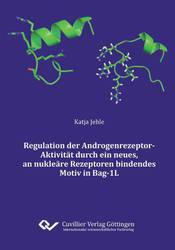| Areas | |
|---|---|
| Serie de libros (96) |
1378
|
| Nachhaltigkeit |
3
|
| Gesundheitswesen |
1
|
| Letra |
2363
|
| Ciencias Naturales |
5406
|
| Matemática | 229 |
| Informática | 319 |
| Física | 980 |
| Química | 1363 |
| Geociencias | 131 |
| Medicina humana | 243 |
| Estomatología | 10 |
| Veterinaria | 108 |
| Farmacia | 147 |
| Biología | 835 |
| Bioquímica, biología molecular, tecnología genética | 121 |
| Biofísica | 25 |
| Nutrición | 45 |
| Agricultura | 1004 |
| Silvicultura | 201 |
| Horticultura | 20 |
| Ecología y conservación de la tierra | 148 |
| Ciencias Ingeniería |
1791
|
| General |
98
|
|
Leitlinien Unfallchirurgie
5. Auflage bestellen |
|
Erweiterte Suche
Regulation der Androgenrezeptor‐Aktivitat durch ein neues, an nukleare Rezeptoren bindendes Motiv in Bag‐1L (Tienda española)
Katja Jehle (Autor)Previo
Lectura de prueba, PDF (200 KB)
Indice, PDF (73 KB)
Kurzbeschreibung
Der Androgenrezeptor (AR) ist ein Steroidhormonrezeptor, der in die Entwicklung von Prostatakrebs involviert ist. Er wird durch die Bindung von Androgenen an die Ligandenbindedomäne (LBD) aktiviert. Nach Ligandenbindung werden Konformationsänderungen induziert, in denen eine hydrophobe Oberfläche entsteht, die gewebespezifische Koaktivatoren bindet. Verschiedene Koaktivatoren binden über konservierte LXXLL- oder FXXLF-Motive an diese hormoninduzierte Konformation, um die transkriptionelle Aktivität des AR zu verstärken. Auch wenn LXXLL- und FXXLF-Motive für verschiedene Koaktivatoren charakteristisch sind, besitzen diese nicht alle Koaktivatoren, was darauf hindeutet, dass andere Bindemotive existieren müssen. In dieser Arbeit wurden Sequenzen im N-Terminus von Bag-1L, einem Koaktivator des ARs, identifiziert, die für dessen Transaktivierung wichtig sind. Die Überexpression dieses Bereichs zeigt einen dominant-negativen Effekt auf die durch den AR vermittelte Genexpression und androgenabhängiges Prostatakrebszellwachstum. Dieser Bereich enthält Motive, die für die Bindung an die LBD des ARs wichtig sind. Besonders an diesen Motiven ist deren Spezifität, die neben dem AR auf den Estrogenrezeptor (ER) α begrenzt ist. Auch dessen Aktivität und das estrogenabhängige Brustkrebszellwachstum werden von dieser Sequenz reduziert. Diese Motive oder Varianten dieser sind auch in anderen AR- und ER-bindenden Proteinen vorhanden. Dies gibt ihnen die Funktion einer neuen Interaktionssequenz, welche sich von LXXLL- und FXXLL-Motiven unterscheidet, aber für die Regulation der AR- und ER-Aktivität und des Prostata-, bzw. Brustkrebszellwachstums wichtig ist.
Description
The androgen receptor is a ligand-dependent transcription factor involved in prostate cancer development. It is activated by binding of androgens to its ligand binding domain which consists of 12 α-helices. Upon ligand binding, a conformational change is induced, in which helix 12 is reconstituted and a hydrophobic surface is formed for tissue specific coactivators binding. Different coactivators use conserved LXXLL- or FXXLL-motifs to bind to this hormone induced conformation to increase transcriptional activity of the receptor. While the LXXLLor FXXLL-motifs are characteristic for different coactivators of steroid hormone receptors, they are not present in all coactivators, meaning that other binding motifs must exist. In this work, the first 128 amino acid of Bag-1L, a coactivator of the androgen receptor has been identified as a region important for transactivation by the androgen receptor. Overexpression of this sequence shows dominant-negative effects on androgen receptor-mediated gene expression and androgen-dependent prostate cancer cell growth. This region contains a duplication of the sequence GARRPR, which was shown to be necessary for androgen receptor binding. An exchange of amino acid residues in both motifs destroyed the binding of the Nterminal Bag-1L sequence to the ligand binding domain of the androgen receptor. It also destroyed Bag-1L mediated transactivation of the androgen receptor, as well as the positive influence of Bag-1L on prostate cancer cell growth. Special for this GARRPR-motif is its specificity, which besides the androgen receptor is limited to estrogen receptor α. Estrogen-mediated activity and estrogen-dependent breast cancer cell growth are also negatively influenced by a sequence of Bag-1L containing both GARRPR-motifs. This Motif and variants thereof were found in other androgen and estrogen receptor binding proteins. This gives GARRPR a role as a new interaction sequence, different from LXXLL- and FXXLL-motifs, but important for the regulation of androgen and estrogen receptor, as well as prostate and breast cancer cell growth.
| ISBN-13 (Impresion) | 9783954043484 |
| Formato | A5 |
| Idioma | Alemán |
| Numero de paginas | 162 |
| Laminacion de la cubierta | mate |
| Edicion | 1. Aufl. |
| Lugar de publicacion | Göttingen |
| Lugar de la disertacion | Karlsruhe |
| Fecha de publicacion | 07.02.2013 |
| Clasificacion simple | Tesis doctoral |
| Area |
Biología
|
| Palabras claves | Kochaperon, nukleäre Rezeptoren, Koaktivatoren, Transaktivierung, Prostatakrebszellwachstum, Genetik, Molekularbiologie |








